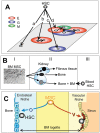Bone marrow mesenchymal stem cells: historical overview and concepts
- PMID: 20565251
- PMCID: PMC4823383
- DOI: 10.1089/hum.2010.115
Bone marrow mesenchymal stem cells: historical overview and concepts
Abstract
This review describes the historical emergence of the concept of bone marrow mesenchymal stem cells (MSCs), summarizing data on Wolf and Trentin's hematopoietic inductive microenvironment; Dexter's hematopoiesis-supportive stromal cells; Friedenstein's osteogenic cells; and Pittenger's trilineal osteoblastic, chondrocytic, and adipocytic precursors; to finally introduce the specific bone marrow mesenchymal stem cells with differentiation potential to four lineages (mesenchymal and vascular smooth muscle lineages), and stromal and immunomodulatory capacities. Two points are the object of detailed discussion. The first point envisions the stem cell attributes (multipotentiality, self-renewal, tissue regeneration, population heterogeneity, plasticity, and lineage priming) compared with that of the paradigmatic hematopoietic stem cell. In the second point, we discuss the possible existence of bone marrow cells with greater differentiation potential, eventually pluripotential cells. The latter point raises the issues of cell fusion, reprogramming, or selection under nonstandardized conditions of rare populations of neuroectodermal origin, or of cells that had undergone mesenchymal-to-epithelial transition. In the last section, we review data on MSC senescence and possible malignant transformation secondary to extensive culture, gene transfer of telomerase, or mutations such as leading to Ewing's sarcoma. The set of data leads to the conclusion that bone marrow MSCs constitute a specific adult tissue stem cell population. The multiple characteristics of this stem cell type account for the versatility of the mechanisms of injured tissue repair. Although MSC administration may be extremely useful in a number of clinical applications, their transplantation is not without risks that must not be overlooked when developing cell therapy protocols.
Figures


Similar articles
-
Bone marrow mesenchymal stem cells: biological properties and their role in hematopoiesis and hematopoietic stem cell transplantation.Stem Cell Rev Rep. 2011 Sep;7(3):569-89. doi: 10.1007/s12015-011-9228-8. Stem Cell Rev Rep. 2011. PMID: 21249477 Review.
-
Conversion of red bone marrow into yellow - Cause and mechanisms.Med Hypotheses. 2007;69(3):531-6. doi: 10.1016/j.mehy.2007.01.052. Epub 2007 Apr 11. Med Hypotheses. 2007. PMID: 17433565
-
Human bone marrow mesenchymal stem cells: a systematic reappraisal via the genostem experience.Stem Cell Rev Rep. 2011 Mar;7(1):32-42. doi: 10.1007/s12015-010-9125-6. Stem Cell Rev Rep. 2011. PMID: 20198518 Free PMC article. Review.
-
Differential expression of cell cycle and WNT pathway-related genes accounts for differences in the growth and differentiation potential of Wharton's jelly and bone marrow-derived mesenchymal stem cells.Stem Cell Res Ther. 2017 Apr 26;8(1):102. doi: 10.1186/s13287-017-0555-9. Stem Cell Res Ther. 2017. PMID: 28446235 Free PMC article.
-
Specific lineage-priming of bone marrow mesenchymal stem cells provides the molecular framework for their plasticity.Stem Cells. 2009 May;27(5):1142-51. doi: 10.1002/stem.34. Stem Cells. 2009. PMID: 19418444
Cited by
-
Differentiation of mesenchymal stem cells from human umbilical cord tissue into odontoblast-like cells using the conditioned medium of tooth germ cells in vitro.Biomed Res Int. 2013;2013:218543. doi: 10.1155/2013/218543. Epub 2013 May 13. Biomed Res Int. 2013. PMID: 23762828 Free PMC article.
-
Similarities Between Stem Cell Niches in Glioblastoma and Bone Marrow: Rays of Hope for Novel Treatment Strategies.J Histochem Cytochem. 2020 Jan;68(1):33-57. doi: 10.1369/0022155419878416. Epub 2019 Sep 30. J Histochem Cytochem. 2020. PMID: 31566074 Free PMC article.
-
Genetically modified mesenchymal stem cell therapy for acute respiratory distress syndrome.Stem Cell Res Ther. 2019 Dec 16;10(1):386. doi: 10.1186/s13287-019-1518-0. Stem Cell Res Ther. 2019. PMID: 31843004 Free PMC article. Review.
-
Potential Application of Orofacial MSCs in Tissue Engineering Nerve Guidance for Peripheral Nerve Injury Repair.Stem Cell Rev Rep. 2023 Nov;19(8):2612-2631. doi: 10.1007/s12015-023-10609-y. Epub 2023 Aug 29. Stem Cell Rev Rep. 2023. PMID: 37642899 Review.
-
Biological functions of mesenchymal stem cells and clinical implications.Cell Mol Life Sci. 2019 Sep;76(17):3323-3348. doi: 10.1007/s00018-019-03125-1. Epub 2019 May 4. Cell Mol Life Sci. 2019. PMID: 31055643 Free PMC article. Review.
References
-
- Adams GB, Scadden DT. The hematopoietic stem cell in its place. Nat Immunol. 2006;7:333–337. - PubMed
-
- Aguilar S, Nye E, Chan J, Loebinger M, Spencer-Dene B, Fisk N, Stamp G, Bonnet D, Janes SM. Murine but not human mesenchymal stem cells generate osteosarcoma-like lesions in the lung. Stem Cells. 2007;25:1586–1594. - PubMed
-
- Alvarez-Dolado M, Pardal R, Garcia-Verdugo JM, Fike JR, Lee HO, Pfeffer K, Lois C, Morrison SJ, Alvarez-Buylla A. Fusion of bone-marrow-derived cells with Purkinje neurons, cardiomyocytes and hepatocytes. Nature. 2003;425:968–973. - PubMed
-
- Armesilla-Diaz A, Elvira G, Silva A. p53 regulates the proliferation, differentiation and spontaneous transformation of mesenchymal stem cells. Exp Cell Res. 2009;315:3598–3610. - PubMed
Publication types
MeSH terms
LinkOut - more resources
Full Text Sources
Other Literature Sources

